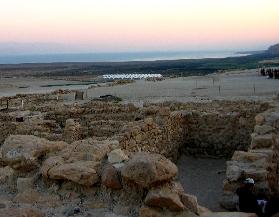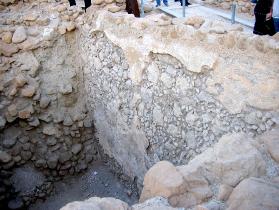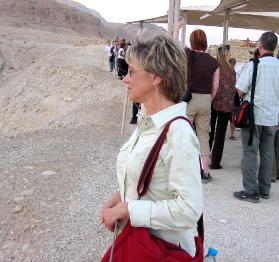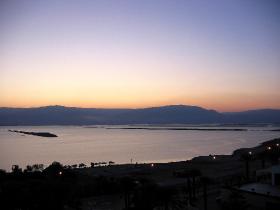 |
|
Israel Journal COLLEEN TINKER |
||||
NUMBER 9 — WEDNESDAY, NOVEMBER 5, 2008
Border crossing, Qumran, and floating in the Dead Sea at night
Today we spent a great deal of time crossing the border from Jordan back into Israel. My experience with border crossing between the USA and Canada or Mexico have not hinted at the complications of border crossings in other parts of the world. It was interesting getting out of our bus at the border and being met by a young man who looked younger than our youngest son holding a BIG gun. We survived, however!
As we drove toward the border Elizabeth told us some details about the significance of the area we visited. As I mentioned before, the area around Petra was the area of the Edomites who had descended from Esau. (Interestingly, the ground is very red there—reminiscent of Esau’s hair!) Herod Anitpas, the other of the two surviving sons of Herod the Great, was in charge of the area of Edom. He is the one who took his brother Herod Philippi’s wife Herodius for his own wife, and he’s the one who, later, beheaded John the Baptist when Herodius’ daughter danced for him and asked for John’s head.
Concurrent with Herod Antipas, King Aretus reigned over the Nabateans. The Nabateans were an early conglomeration of Arabs in the region. Aretus had a daughter whom Herod Antipas decided he wanted for a wife, but Herod Antipas refused to divorce Herodius to marry her. Antipas took the daughter and married her anyway, but her dad Aretus was mad. He declared war on Antipas, and in the process of that war, Herod Antipas was killed.
Jewish historian Josephus writes that Herod Antipas’ death in this war was God’s judgment on him for beheading John the Baptist.
Also, there is some thought that during the ten years’ after Paul’s Damascus Road experience, this wilderness area in Jordan is part of the desert area to which Paul went, bearing witness of his encounter with the Lord Jesus, before going to Jerusalem and being received by the apostles there and beginning his mission to the Gentiles “officially”.
Qumran and the Dead Sea scrolls
This afternoon we drove to Qumran, the place where the Dead Sea scrolls were found. It was in 1947 when a Bedouin boy idly tossed a stone into a cave, expecting to hear a faint “plop” as the stone hit water deep inside. Instead, the boy heard the sound of something breaking.
Immediately he thought he had hit treasure, and imagine his deep disappointment when he found that he had “merely” discovered some clay pots containing some old scrolls. But the rest is history…
At Qumran we visited the ruins of the ancient enclave where the Essenes used to live. The Essenes were a group of Israelites from the priestly line who rejected the temple. They were concerned about living in ritual purity and in preserving the biblical documents in the case of destruction or war in Jerusalem. They believed a day was coming when the temple would be attacked and/or destroyed, and they took very seriously their job of copying the ancient documents as well as in writing the dictates of their own sect. They also moved out of Jerusalem and established their own ascetic community that resembled a monastic life.
There is mystery surrounding the hiding of the Dead Sea scrolls; who did it, how did he/they do it etc, are questions not completely able to be answered. We do know, however, that the scrolls inside those clay pots that Bedouin found were not only copies of the Bible. Some of the scrolls were copies of the Essenes’ internal “rule book” describing their own community’s requirements and practices. But among those documents is an ancient copy of the nearly entire book of Isaiah as well as fragments of other OT books and commentaries on still others.
Before we toured the ruins of Qumran where the community —probably the Essenes—lived and where the caves containing the pots were found, Gary talked to us about the two main contributions of the Dead Sea scrolls.
- They have given us insight into Jewish life that has confirmed details of the gospels.
- They have given us insight into the authenticity of the biblical literature.
For example, some thought that the book of John had been influenced by Greek thought. The books of the Essenes found among the scrolls have revealed that John was actually speaking to a Jewish world. Idioms and references some scholars thought were Greek rather than Jewish have proven to be Jewish indeed. Hence, the extra-biblical insight from the Essene’s own internal literature has confirmed the validity and authenticity of the NT writers.
Second, prior to the discovery of the Dead Sea scrolls, the oldest manuscript copy of the Hebrew Old Testament was dated about 1,000 AD. The tradition of the scribes and later the monks who hand-copied the Scriptures was meticulous; they would destroy whole pages if they discovered they made any mistake in their copying. Nevertheless, we know that the occasional scribal error would creep into the text.
The fact that the oldest manuscripts of the Hebrew portions were as recent as 1,000 AD caused many scholars to suggest that the Bible was not reliable. It had been copied too many times, and we couldn’t be sure it was accurate.
Finding the Dead Sea scrolls suddenly gave the world a set of manuscripts including the book of Isaiah dating a full 1,000 years earlier than had ever been available before. When scholars began verse by verse comparisons of the old and the new, they found that almost no changes of any significance had occurred. The text remained intact.
To be sure, there were small scribal differences, but they were largely inconsequential. Gary told us of one in Isaiah 53, however, where it said about the coming Messiah that “He shall see the travail of his soul and be satisfied.” In the Dead Sea scrolls, however, that passage actually reads, “He shall see the travail of his soul and shall see the light of day and be satisfied.”
Gary commented that many Christina scholars look at that and wonder if in that phrase “see the light of day” there might actually have been a prophetic reference to the resurrection.
As we wandered among the remaining ruins of the Essene community and saw one of the caves (number 4, to be exact) where some of the scrolls were found, I thought about the significance of Jesus being led into the Judean desert to be tempted. This area around the Dead Sea is part of the Judean desert, and it is the most bleak, desolate of deserts. It is completely dry; nothing grows on the hills. The annual rainfall here is 2 inches per year. Those 40 days would have been deadly. It’s clear that God kept Jesus alive—for the purpose of going through His temptation.
Floating under a crescent moon
Last night, by the time we got to our hotel, it was dark, but most of us on the bus decided that we hadn’t come this far to swim in a hotel pool full of piped-in Dead Sea water. We wanted the REAL sea. Our guide arranged for the hotel dining room to remain open longer than usual to accommodate us crazy Americans (my term, not hers!), and many of us traipsed the couple of blocks to the shore of the sea and floated in the slippery water under a clear crescent moon. It was an unforgettable experience!
The Dead Sea is approximately 30% salt; a regular ocean is between 3 and 4%. It is saltier even than the Great Salt Lake in Utah. One cannot stay in long because the high concentration of minerals begins to irritate the skin, but the buoyancy is amazing. One cannot swim in the sea because one must not get the water into the eyes or even one drop in the mouth. The Dead Sea has become, however, a recognized area for therapeutic treatments, and some insurances even cover a stay at a Dead Sea clinic or spa as a recognized, tested form of therapy for certain conditions. Also, as our guide said, the Dead Sea contains enough potash for the entire word’s fertilizer supply for thousands of years!
It is Thursday morning as I finish writing this; today we go to Masada and Bethlehem!
Copyright 1999-2008 Graphics Studio, Redlands, CA USA. All rights reserved. Revised November 17, 2008. Use of this site and forum signifies your acceptance of the Terms and Conditions. Send comments and questions to formeradventist@gmail.com

 The Essenes used lots of water for ritual baths. This may be a water storage pit.
The Essenes used lots of water for ritual baths. This may be a water storage pit. Cave number four where many ancient Biblical scrolls were discovered.
Cave number four where many ancient Biblical scrolls were discovered. Colleen looks across the canyon towards cave number four.
Colleen looks across the canyon towards cave number four. The Dead Sea at sunrise from our hotel window.
The Dead Sea at sunrise from our hotel window.